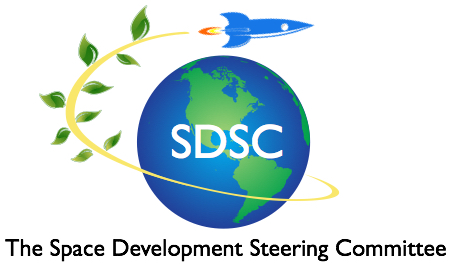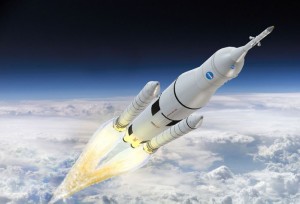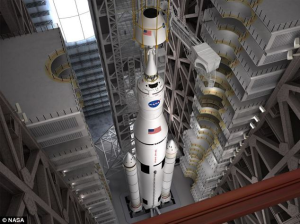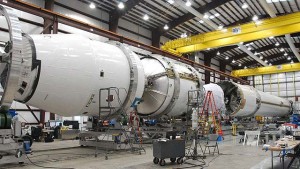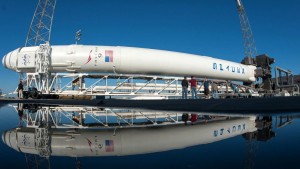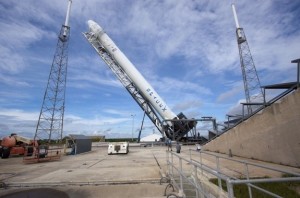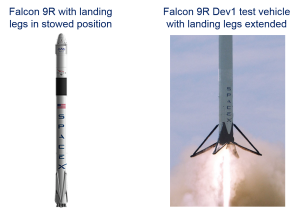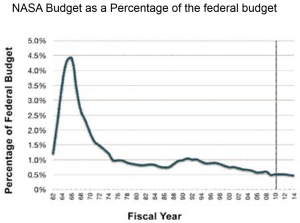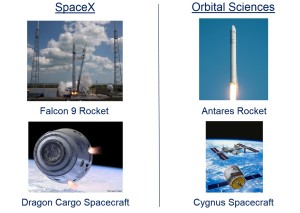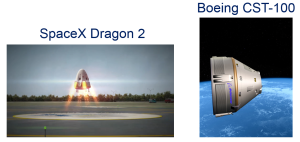by Gerald Black
Gerald Black is a retired aerospace engineer with more than 40 years experience in the industry. After graduating from college, he first worked for Bell Aerosystems Co. in the Buffalo, New York area from 1967 to 1968 as a Rocket Test Engineer. One of the engines he helped test was the engine for the ascent stage of the Apollo Lunar module. Later he worked for more than 39 years for GE Aviation in Evendale, Ohio.
He is currently Chair of the Ohio Chapter of the Mars Society
He also presented at the Mars Society Annual Convention in League City, Texas on August 7, 2014.
ABSTRACT
For this document, a heavy lift launch vehicle is defined as a launch vehicle with the payload capability of the Apollo Saturn V launch vehicle or greater. The current heavy lift launch vehicle strategy is built around a single vehicle, the Space Launch System (SLS). A heavy lift launch vehicle is needed to support beyond earth orbit missions, but the SLS is not the right vehicle for this purpose. For a variety of reasons, its development and operational costs have rocketed into the stratosphere. The SLS is based on Apollo era and Space Shuttle era technology when much better solutions are now available. This paper covers the advances in technology that have made the SLS obsolete before ever being flown.
The SLS should be replaced with a new heavy lift launch vehicle that is reusable to the fullest extent practical. This would enable vastly lower operational costs and much higher launch frequency. In addition, changes are needed to the acquisition process that will also greatly reduce the cost. Done properly, the development cost for a reusable heavy lift launch vehicle would be much lower than for the SLS. Development could also proceed at a faster pace than for the SLS.
IS A HEAVY LIFT LAUNCH VEHICLE NEEDED?
The first question to ask is whether a heavy lift launch vehicle is the right solution for beyond earth orbit missions such as human missions to the moon or Mars. The answer is clearly yes. A launch vehicle with at least as much payload capability as the Saturn V that took us to the moon is vital, and higher payload capability would be even better. Less capable launch vehicles would result in too many critical launches, thus reducing the chances of mission success. This is especially true for human missions to Mars.
We also need a heavy lift launch vehicle to provide for the large diameter modules needed for human missions beyond earth orbit. Current launch vehicles have a payload shroud diameter of about 5 meters or less. However, the Mars Habitation Module envisioned for the Mars Direct mission architecture is about 8 meters in diameter, and that’s for a 4 person crew1. Other human Mars mission architecture studies, such as NASA Design Reference Mission 5.02 call for a 6 person crew, which would require a larger habitation module and a payload shroud diameter of 10 meters. The SLS is, in fact, designed to accommodate a payload shroud diameter of 10 meters, which is about double that of any current launch vehicle.
HISTORY OF THE SPACE LAUNCH SYSTEM
The origin of the Space Launch System (see figure 1) traces back to the “Vision for Space Exploration” announced by President George W. Bush on January 14, 2004. This plan was conceived in response to the Space Shuttle Columbia disaster, the state of human spaceflight at the time, and as a way to regain public enthusiasm for space exploration. The plan became known as the Constellation program3, with the goal of returning humans to the moon no later than 2020 and with Mars as the ultimate goal.
The Ares I and the Ares V launch vehicles and the Orion spacecraft were under development as part of the Constellation program. Ares I was intended to carry crew to earth orbit – both to and from the International Space Station (ISS) as well as crew that would rendezvous with other hardware launched by the Ares V for missions beyond earth orbit. The Ares V was a heavy lift launch vehicle that was intended for launching cargo for human missions beyond earth orbit. Orion was a crew capsule that would be used to carry crew to and from the ISS as well as for beyond earth orbit missions.
A review of the human spaceflight plans was conducted by the Augustine committee in 2009 soon after Barack Obama became president. The committee found that the Constellation program was far behind schedule, over budget, and drastically underfunded. The Augustine report stated that if the then current program was continued constrained to the federal year 2010 budget level “The heavy-lift vehicle, Ares V, is not available till the late 2020s, and there are insufficient funds to develop the lunar lander and lunar surface systems until well into the 2030s, if ever”.4
Consequently, President Obama originally proposed cancelling the Constellation program including the Ares I, Ares V, and Orion spacecraft. This program would be replaced by a program to develop commercial vehicles to take astronauts to and from the International Space Station. In addition, a new hydrocarbon rocket engine would be developed that would be used in a new heavy lift launch vehicle to be developed at a later date.
Some influential members of congress fought back, and a compromise was reached. The Constellation program was cancelled and development of commercial crew vehicles to take astronauts to and from the International Space Station was begun. The Orion spacecraft survived, but it would be used for beyond earth orbit missions only. The Ares I launch vehicle was cancelled. The Ares V launch vehicle was replaced by the Space Launch System, which is essentially the same as the Ares V launch vehicle except that it would be capable of carrying crew as well as cargo. Plans to develop a new hydrocarbon rocket engine were dropped.
Powerful senators concerned with preserving jobs in their states drew up legislation dictating that the Space Shuttle infrastructure, hardware, and workforce would be used for the SLS, and current contractors and the existing contracts would be continued. This locked in the major suppliers and severely limited competition. It also meant that the SLS would be developed under the traditional cost-plus contracts and be subject to the rules of the Federal Acquisition Regulation, which means lots of NASA oversight on decisions and extra paperwork. All these factors would drive up the cost.
The legislation written by the senate (the NASA Authorization Act of 20105) further specified that the initial version of the SLS would have a payload of between 70 and 100 metric tons to low earth orbit, with growth to 130 metric tons or more, and that the initial launch would take place in 2016. It is never a good idea for legislators to become involved in defining vehicle specifications and program schedule, a job which should be left to the engineers. Because the senate legislation established the major design parameters of the system, the SLS became known in some circles as the “Senate Launch System”. Also, because there isn’t enough money left in the NASA budget to design other needed hardware for beyond earth orbit missions such as a deep space habitation module, the SLS became known as the “Rocket to Nowhere”. Reference 6 provides further details about the SLS history and the politics involved.
PROBLEMS WITH THE SPACE LAUNCH SYSTEM
- Use of Legacy Infrastructure and Hardware Components
The SLS design is based on legacy infrastructure and hardware components that date back to the Apollo and the Space Shuttle programs and even earlier. Just like the Apollo Saturn V and the Space Shuttle, the SLS is assembled vertically in the Vehicle Assembly Building atop a Mobile Launcher Platform (see figure 2). The Mobile Launcher Platform and launch vehicle is then transported to the launch pad atop a crawler-transporter.
The major problem here is that horizontal assembly is much more efficient. The horizontal assembly method was pioneered by the Russians and has been used on all Russian launch vehicles. This includes the N1 rocket (the giant Russian heavy lift launch vehicle for their manned lunar program that failed in all 4 launches before it was cancelled) and the Russian Buran spacecraft (similar to our Space Shuttle except the Buran spacecraft flew only one time). Horizontal assembly is also used on the most modern U.S. launch vehicles, including SpaceX’s Falcon 9 and Orbital Science Corporation’s Antares launch vehicles.
After arriving at the launch pad the Space Shuttle underwent weeks of processing prior to launch, subjecting the vehicle to possible bad weather. For the STS-117 mission of Space Shuttle Atlantis, there was a freak hail storm that did so much damage to the insulation on the External Tank that the Space Shuttle had to be wheeled back to the Vehicle Assembly Building for repairs. This delayed the launch by almost 3 months7. By contrast, following horizontal assembly, SpaceX’s Falcon 9 launch vehicle can be transported horizontally from the hanger to the launch pad, erected vertically at the launch pad and launched all in the same day (see figures 3 through 5). Another recent achievement by SpaceX was launching two satellites into orbit only two weeks apart from the same launch pad (on September 7 and September 21, 2014).
The SLS is constrained to use Space Shuttle components and workforce to the maximum extent practical by the NASA Authorization Act of 20105. For instance, the side mounted boosters are modified Space Shuttle solid fuel boosters except with 5 segments instead of 4 for extra performance. Similarly, the rocket engines for the core stage are modified Space Shuttle RS-25 main engines. The core stage utilizes much of the same tooling and the same workforce as the Space Shuttle External Tank. The contractors for these major components are the same contractors as for the Space Shuttle. Thus there has been very little competition in the development of the SLS. This fact, coupled with the cost-plus contracts that are subject to the Federal Acquisition Regulation has been contributing to the ballooning cost of the SLS.
Use of components designed at the beginning of the Space Shuttle program or before means that we are also not taking advantage of modern materials and modern manufacturing techniques. The RL10 engine used in the second stage of the Block 1 configuration of the SLS (and perhaps later configurations also) even predates the Apollo program, having been designed in the 1950s and having had its first flight in 19618. It is one of the most costly engines in its class.
Other problems also arise from using legacy infrastructure and hardware components. This puts limits on design parameters, resulting in less than optimal design. For instance, there is a limit on the length of the Exploration Upper Stage (the second stage of the Block 1B and Block 2 configurations of the SLS) because exceeding a 60 foot length would impede the existing crew access arm’s adjustability limits to provide safe and necessary access to Orion9.
PROBLEMS WITH THE SPACE LAUNCH SYSTEM
- None of the Space Launch System Components are Reusable
The main reason that the SLS will be obsolete before it ever flies is that none of the components are reusable. The core stage, the side mounted boosters, and the second stage are all discarded after each launch. Such waste was excusable for the Apollo Saturn V rocket, because the primary objective was to beat the Russians and cost was a very minor consideration. However, if we are to become a truly spacefaring nation we must do better.
The commercial space industry has been pioneering the development of reusable rockets for both suborbital and orbital use. Ten years ago, the suborbital space tourism industry appeared ready to take off after SpaceShipOne won the Ansari X prize in 2004. That effort has stalled, but recently SpaceX has been pioneering the development of a reusable orbital launch vehicle with their Falcon 9R rocket (the reusable version of the Falcon 9 rocket).
Thus far this year (as of October, 2014) SpaceX has launched 6 spacecraft into orbit. On 2 of these launches SpaceX achieved controlled ocean soft touchdowns of the first stage of the Falcon 9R launch vehicle. Unfortunately, in each case recovery failed because hull integrity was breached when the rocket toppled over (as designed) following the soft ocean touchdown.
In an interview at the MIT Centennial Symposium on October 24, 2014 Elon Musk (founder, CEO, and CTO of SpaceX) revealed some details about plans for reusing the Falcon 9R10. SpaceX is now building a 170×300 foot floating platform at a shipyard in Louisiana in order to recover the Falcon 9R first stage at sea10. SpaceX will attempt to land the first stage on this floating platform in the Atlantic Ocean on the next launch of the Falcon 9R, now scheduled for December 9, 2014. Elon Musk estimated no better than a 50-50 chance of a successful ocean platform landing on the first attempt. However, over the dozen or more launches in the next year, he estimated 80 to 90 percent odds of a landing that would enable a rocket to reused. After demonstrating soft touchdowns on the ocean platform, SpaceX hopes to transition to landing the first stage on land near the launch site.
SpaceX has also been testing their Grasshopper and Falcon 9R dev1 test vehicles to help perfect vertical landing capability. The Falcon 9R has retractable landing legs which are in the stowed position for launch, and then extended for landing (see figure 6).
Thus, SpaceX is in hot pursuit of reusability and it appears likely that they will achieve recovery of the first stage of their Falcon 9R orbital launch vehicle within the next year or two. This would be a remarkable achievement and would have a disruptive effect on the launch vehicle industry. Since the thermal and aerodynamic loads on the first stage are fairly small, the first stage should be capable of reuse with very little if any refurbishment.
The Falcon 9R will be only partially reusable since only the first stage will be reused and the second stage discarded. In the past SpaceX had talked about making the second stage reusable also, but in the interview at MIT10 Elon Musk indicated they are abandoning that idea due to practical considerations. Most of the Falcon 9 launches will be to geostationary earth orbit, which makes recovery difficult. Also, the second stage performance (specific impulse) is not quite good enough to make recovery practical.
In spite of reusing only the first stage, SpaceX will still realize huge cost savings on the Falcon 9R, since the first stage (which has 9 engines) is 75% of the cost, and the second stage (which has only 1 engine) is only 25% of the cost. Elon Musk also said in the interview10 that the next new launch vehicle (after the Falcon 9 and the Falcon Heavy) will be a heavy lift launch vehicle that will use liquid oxygen and liquid methane propellants, and this vehicle will be designed to be fully reusable.
The reason that reusability is so important is that the cost of propellants is only .3% of the cost of the launch11. The vast majority of the remaining cost is in the launch vehicle, which is used only one time. Space launch vehicles are the only form of transportation where the vehicle is used for a single trip and then discarded. If commercial airplanes were flown only once and then discarded there wouldn’t be hardly any air transportation industry. It is especially advantageous to reuse the first stage of a rocket, since that is the most expensive component of the launch vehicle and can be reused with very little if any refurbishment.
Reusability will also help insure that that a humans to Mars program is not simply a “flags and footprints” mission like Apollo was, but will be a sustainable program.
PROBLEMS WITH THE SPACE LAUNCH SYSTEM
- The SLS is subject to a flat budget that stays relatively constant
The SLS is being developed under a flat budget that stays about the same every year (about $1.8 billion dollars/year). This amount is proving to be insufficient to keeping the program on schedule. In order to begin flights in a reasonable period of time, the flat budget necessitates a phased development program with different configurations. The NASA Authorization Act of 20105 mandates that the first configuration will have a payload of between 70 and 100 tons to low earth orbit, with growth to 130 metric tons or more.
NASA now plans 3 major configurations for the SLS. The reason is that, in order to go from the 70 metric ton configuration to the 130 metric ton configuration two major changes are needed. The first change is a better performing upper stage, and the second change is advanced side mounted boosters. The problem is that with the flat budget NASA can’t afford to pay for both these changes at the same time, so these changes will be done in sequence.
Figure 7 shows the first two major configurations of the SLS. Block 1 (shown on the left) is the initial configuration that can launch 70 metric tons to low earth orbit. This version has side mounted boosters that are modified solid fuel Space Shuttle boosters except they have 5 segments instead of 4 for improved performance. The second stage is called the Interim Cryogenic Propulsion Stage (ICPS) and is a modified version of the upper Stage of the Delta IV launch vehicle (but with upgraded avionics). It uses a single RL10 rocket engine that utilizes liquid hydrogen and liquid oxygen propellants.
Only a crew version of the SLS Block 1 will be flown (crew version as used here means that the payload includes the Orion spacecraft but may or may not carry astronauts). According to the NASA Authorization Act of 2010, the first launch of the Block 1 configuration was to take place in 2016. In 2011, however, NASA announced this launch would instead take place in 2017. Then, earlier this year NASA announced that based on a risk analysis the first launch would occur no later than November of 2018 with a 70% confidence level12. The first flight will be unmanned, and as of this writing it is uncertain whether there will be a second flight of the Block 1 configuration (manned) or whether NASA will proceed directly to the Block 1B configuration.
The second major configuration of the SLS is the Block 1B configuration. In figure 7 both a cargo version (middle) and a crew version (right) of the Block 1B configuration are shown. This differs from the Block 1 configuration in that the Interim Cryogenic Propulsion Stage (ICPS) will be replaced by the Exploration Upper Stage (EUS). In September of 2014 NASA issued a Request for Information13 soliciting information from industry regarding the choice of engine for the EUS, though it appears from the wording of the RFI that the tentative choice is for the EUS to be powered by four RL10 rocket engines. It is unclear as of this writing whether there will be a competition to produce the EUS stage or the EUS engine.
The Block 1B configuration will be capable of launching roughly 105 metric tons to low earth orbit, though that may change as the Exploration Upper Stage becomes further defined. This is still a bit less than the capability of the Apollo Saturn V, which could launch 118 metric tons to low earth orbit14. The second flight of the SLS is tentatively scheduled for 2021, but as of this writing it is unclear whether the second flight will be another flight of the Block 1 configuration or the first flight of the Block 1B configuration.
The Block 1B configuration is the configuration chosen by the Inspiration Mars Foundation for the proposed human flyby of Mars and Venus that would launch in 2021. A commitment from the President and from congress and a substantial increase to the NASA budget would be needed to make this mission happen. Whether this occurs remains to be seen. At this time it looks unlikely.
The third major configuration of the SLS is the Block 2 configuration. This is the same as the Block 1B configuration except the Space Shuttle derived solid fuel side mounted boosters would be replaced by advanced side mounted boosters that may use either solid fuel or liquid fuel. NASA is planning a competition for the advanced side mounted boosters. However, this competition won’t take place anytime soon since the money to pay for development of the Block 2 configuration isn’t likely to be available till sometime in the 2020s. This configuration would be able to launch 130 metric tons or more to low earth orbit. This exceeds the capability of the Apollo Saturn V, which could launch 118 metric tons to low earth orbit14.
It is the Block 2 configuration of the SLS that is needed for human missions to orbit Mars or land on Mars. NASA administrator Charles Bolden has stated on more than one occasion that the SLS Block 2 configuration won’t be needed till the 2030s. Thus, there is no sense of urgency, and decisions are being made very slowly. Barring increased priority and increased funding, this configuration is not likely to become available till the early 2030s, if ever.
The flat budget and subsequent phased development with 3 configurations does hold down the cost in any one year, but it greatly adds to the total cost of the program. It creates duplication, since the plan is to develop two upper stage designs and two side mounted booster designs over the course of the program. Each major new configuration should have an unmanned flight first before carrying humans, which adds to the cost and schedule. Spreading the development out over so many years prolongs the time that salaries must be paid. All these issues are causing the total cost of the SLS program to get out of control.
Instead of a flat budget with the same expenditures every year, it is much more efficient in the long run to apply increased funding as the need arises. It’s instructive to compare the flat budget of the SLS program with the budget of the Apollo program back in the 1960s. Figure 8 shows the NASA budget as a percentage of the overall budget from the years 1962 through the year 2014. All the components of the Apollo program were developed in parallel rather than sequentially. This necessitated a steep increase in funding for all the engineering development, tooling, manufacturing procurement and testing that needed to be done. Funding peaked in 1966, then decreased rapidly as the Apollo program shifted to the lower cost operational phase. The year 1966 and close to it was expensive, but applying more funds when needed greatly reduced the total cost of the program. The Apollo program was efficiently run, cost about $20 billion dollars which was about what was estimated, and met its goal of landing humans on the moon by the end of the 1960s decade15.
In contrast to the way that the SLS is being developed, all components of the Apollo Saturn V launch vehicle were developed in parallel, so that the first flight of the Saturn V was the final configuration of the vehicle. The second flight of the Saturn V was the first manned mission. That flight was Apollo 8, which was the first human mission to orbit the moon. The Saturn V succeeded in all its launches.
PROBLEMS WITH THE SPACE LAUNCH SYSTEM
- The Low Launch Rate Planned for the SLS
The first two missions for the SLS are now planned for 2018 and 2021. Currently NASA is planning no more than one SLS launch every two years during the 2020s. Both the NASA Advisory Council and the Aerospace Safety Advisory Panel have expressed concern over this low launch rate. They point out that this low launch rate would adversely affect the proficiency of the launch team, safety, and cost.
The launch rate could be increased, but this would require a substantial increase in the NASA budget. NASA has not had enough funding to develop any of the hardware needed for beyond earth orbit missions other than the SLS and Orion, and the agency has been vague regarding the details of missions that would use the SLS. Proponents of the SLS forecast increased funding and a faster launch rate, but this may just be wishful thinking.
The lack of reusability and the low flight rate result in a very high cost per flight. This is a problem since no one except NASA would consider using the vehicle even if NASA were to allow this.
PROBLEMS WITH THE SPACE LAUNCH SYSTEM
- The High Cost of the SLS
In 2011 NASA hired the management consulting firm Booz Allen Hamilton to do an independent study of the SLS, Orion, and ground systems costs. Their report16 stated that NASA’s cost estimates could only be relied on for the first 3 to 5 years of program development. Another finding was that program estimates were shaped to fit within the anticipated budget profile – shifting costs to later years and increasing the risk of cost growth. In addition, there were many instances of unjustified cost reductions in the program estimates. The report also found that the program lacks sufficient reserves to cover unexpected problems in development.
In July of 2014 the General Accounting Office issued a report on the Space Launch System17. The report stated that NASA admitted to a 90% chance of missing the December 2017 date for the first launch of the SLS. The estimated 6 month delay would cost the program an extra $400,000,000. NASA has estimated the cost of the SLS through 2017 at $12 billion dollars but has not provided cost estimates past 2017. The GAO report criticized NASA for only providing cost estimates through 2017, so that the life cycle costs and the long term affordability of the program is unknown. To promote affordability, the report also recommended competition for future capability enhancements such as the higher performance upper stage (Exploration Upper Stage).
NASA has not provided a cost estimate for the SLS through development of the 130 metric ton configuration, and external estimates are unreliable. However, the costs will certainly be well in excess of $20 billion. By contrast, SpaceX stated they could develop a 150 metric ton version for $2.5 billion under a fixed-price contract18. Clearly the SLS is costing far more than it should.
Reasons that the SLS is costing more than it should include the use of legacy infrastructure and hardware components, the lack of reusability, the flat budget, and the low launch rate as discussed previously. Other reasons include the lack of any meaningful competition and the fact that the SLS is being developed under cost-plus contracts that are subject to the Federal Acquisition Regulation. The problem with cost-plus contracts is that there is no incentive to contain costs. All major decisions must be approved by NASA and all costs itemized, resulting in inefficiencies and excessive paperwork.
This is not to say that cost-plus contracts are not appropriate for certain programs. They are appropriate for programs of importance that are technically challenging and therefore whose costs are difficult to estimate. The Manhattan project that created the first atomic bombs is one such example. However, cost-plus contracts are not appropriate for a heavy lift launch vehicle, which we mastered the ability to build more than 45 years ago with the Saturn V.
IS THERE A BETTER WAY GOING FORWARD?
The SLS is not the right solution for our heavy lift launch vehicle needs due to its obsolete design and excessive development costs and operational costs. Yet there is a clear need for a heavy lift launch vehicle to support beyond earth orbit missions. So the question to be asked is whether a better design could be developed with lower development and operational costs and how?
Fortunately, there is a much better way forward. We should follow the example of two NASA programs that have been highly successful at containing costs. These programs are the commercial cargo program for resupplying the ISS, and the commercial crew program for transporting astronauts to and from the ISS.
The commercial crew and commercial cargo programs did not use the traditional cost-plus contracts, and these programs were open to any company that wished to compete. Rather, Space Act Agreements were used for the initial competition for hardware development. The Space Act Agreements are not binding contracts but rather payment for milestones achieved. During this phase of the competition, the competitors are free to make all design decisions. This does not mean the competitors don’t consult with NASA and take into account advice NASA gives. In fact there is a lot of communication going back and forth which helps refine the design. But since the competitors make the design decisions on their own, it eliminates a lot of inefficiencies.
The competitors also contribute money for development during the Space Act Agreement phase, which they do in the hope of winning future business. This contrasts with the cost-plus contracts where NASA pays the entire cost-plus an additional payment to allow for profit.
Following the Space Act Agreements, fixed-price contracts were awarded to the competition winners. These are legally binding contracts, meaning the suppliers are liable if they fail to perform. For the fixed-price contracts there is increased NASA oversight, especially for the commercial crew contract. For the commercial crew contract “Joint Test Teams” will be set up and NASA will oversee some decisions19, which is appropriate since NASA is responsible for the safety of their astronauts. Safety is not being neglected on this program. However, unlike the cost-plus contracts, detailed cost data is not required.
The commercial cargo program produced two new spacecraft and two new launch vehicles, namely the Dragon spacecraft and the Falcon 9 launch vehicle by SpaceX, and the Cygnus spacecraft and the Antares launch vehicle by Orbital Sciences Corporation (see figure 9). NASA conducted a study and found that if it had developed the Falcon 9 itself that it would have cost between 3 and 8 times as much as it cost SpaceX. All five missions by SpaceX and 3 out of 4 missions by Orbital Sciences to deliver supplies to the ISS have been successful.
The commercial crew program has also been highly successful. The winners of the fixed-price contracts were announced on September 16 of 2014. They were Boeing with their CST-100 capsule, and SpaceX with their Dragon 2 capsule (see figure 10). The third finalist, Sierra Nevada with their Dream Chaser spaceplane was eliminated, though Sierra Nevada has filed a protest of the award. The cost of this program, including all the competitors combined, has been much less than for the Orion spacecraft, which is a program of approximately equal complexity but which is being developed under a cost-plus contract.
The commercial crew program differs from previous NASA programs in that it involves a public-private partnership. The supplier acts like a rental car agency. NASA will not own the spacecraft, but rather rents them out to take their astronauts to and from the ISS. The supplier is free to use their spacecraft for other purposes, such as space tourism. This is a huge incentive for the competitors. Sierra Nevada has said it will continue development of their Dream Chaser spaceplane even though they didn’t win a NASA contract. The commercial crew program is also likely to invigorate the orbital space tourism industry, since it will lead to lower prices and more opportunities than is afforded by the Russian Soyuz spacecraft.
NASA ADVISORY COUNCIL CONCERNS WITH HUMAN SPACEFLIGHT PLAN
A NASA Advisory Council meeting was held on July 30 & 31 of 2014, and their concerns were reported in the press20. The NASA Advisory Council is a group of experts that gives advice to the NASA Administrator, Charles Bolden. One of their concerns is that the planned launch rate for the Space Launch System of once every 2 years is unacceptably low, as it adversely affects the proficiency of the launch team, safety, and cost.
Another concern expressed in the meeting is that the human spaceflight program plan of sending humans to Mars in the 2030s is just not possible under the reasonably expected NASA budgets. In fact, NASA has admitted that the plan would require budget increases higher than the inflation rate. The problem is that just about no agency of the government is receiving budget increases higher than the inflation rate year after year. The budgets of most agencies are being cut. In fact, in recent years the NASA budget has not increased as fast as inflation, and in some years the budget has even decreased in real terms. Thus, assuming the budget will increase at higher than the inflation rate is not reasonable and may be just wishful thinking.
Tom Young, a member of the council and the former director of the Goddard Spaceflight Center stated “we are collectively perpetuating a fraud” by pretending that the program is executable. He said he worries that the country will spend $160 billion on human spaceflight over the next 20 years and be only “negligibly closer” to landing humans on Mars.
These concerns echo those of the Augustine report of 20094. The NASA human spaceflight program is drastically underfunded and hence very little progress is being made. With no assurance that more funding will become available, clearly there is a need to change course and reduce costs.
OPPOSITION TO THE SLS
Several space advocacy organizations have called for cancellation of the SLS, including the Space Access Society, the Space Frontier Society, and the Planetary Society20. Also, several well informed supporters of the space program have also come out in opposition to the SLS, including such luminaries as Christopher Kraft (former Flight Director at Johnson Spaceflight Center) and Buzz Aldrin (astronaut). Mars Society founder Robert Zubrin suggested that a heavy lift launch vehicle should be developed for $5 billion on fixed-price requests for proposal21. One of the most vocal opponents of the SLS has been Rick Boozer, who wrote a book on the subject6.
CONCLUSIONS
The SLS program should be terminated and replaced by a competition to develop a heavy lift launch vehicle. The competition should require that at least the first stage and boosters attached to the first stage (if any) be reusable, and that the launch vehicle be designed to minimize operational costs. Space Act Agreements should be used for the competition, and fixed-price contracts should be awarded to the competition winner(s). This follows the example of the highly successful commercial cargo and commercial crew programs.
The new heavy lift launch vehicle program should be a public-private partnership similar to the commercial crew program, whereby NASA does not own the launch vehicles but rents them out for beyond earth orbit missions. The suppliers would then be free to market the launch vehicle for use by the commercial space industry. Since the operational costs would be a small fraction of what they would be for the SLS, there would be the potential for lots of new business that would entice the launch vehicle supplier(s) to invest their own money. Possibilities include much larger communication satellites, commercial space stations acting as hotels for space tourists, and tourist flights to the moon. By contrast, the SLS is so expensive that no one except the government would ever consider using it.
If these guidelines are followed, this would result in a better, more modern design with much lower development and operational costs. The current plan with slow, phased development of the SLS means that the final configuration that can launch 130 metric tons or more to low earth orbit won’t be ready till the early 2030s. By contrast, all components of the new heavy lift launch vehicle could be developed in parallel, enabling the vehicle to become operational much sooner.
Certainly the SLS program will be cancelled eventually, since it is beset with problems and will make less and less sense once SpaceX demonstrates rapid reusability of the first stage of the Falcon 9 launch vehicle. However, it would be much better if this is done sooner rather than later. Since development of a reusable heavy lift launch vehicle would cost less than the SLS if done using Space Act Agreements and fixed-price contracts, it would free up money to work on the development of other needed hardware for beyond earth orbit missions, such as a deep space habitation module.
It would be very difficult for any company to develop a reusable heavy lift launch vehicle on its own, especially since the major customer (NASA) is committed to the SLS. SpaceX is the only private company with enough audacity to pursue this. A heavy lift launch vehicle though is a major undertaking requiring large expenditures, much greater than for smaller launch vehicles. It is hard to imagine that SpaceX could by itself devote the necessary resources to make rapid progress in this endeavor without risking bankruptcy. A competition to develop a reusable heavy lift launch vehicle would greatly speed up development of such a vehicle and make it more certain that this endeavor will succeed.
Recently the National Research Council came out with a report22 that referred to a human Mars program as costing “hundreds of billions of dollars”. This report was widely criticized (and rightly so) because, while it talked about international partners to help bring down the cost, it left out any mention of commercial partners. The report did not even mention the possibility of a commercial alternative to the SLS. Rather, it just assumed that NASA would continue along the path of the SLS and Orion and continue the traditional cost-plus acquisition method for its humans to Mars program.
The National Research Council was wrong. A human Mars program needn’t cost “hundreds of billions of dollars” if done wisely. One key to containing the cost is a reusable heavy lift launch vehicle and other such innovations. Another key strategy is to partner more with the commercial space industry and to utilize Space Act Agreements and fixed-price contracts instead of cost-plus contracts.
Both the general public and our leaders have the perception that a human Mars mission is just too expensive. A reusable heavy lift launch vehicle is exactly what is needed to change that perception and help us reach that goal.
REFERENCES
- Zubrin, Robert, The Case for Mars, The Free Press, 1996, p. 7.
- Drake, Bret G., editor, Mars Architecture Steering Group, NASA Headquarters, NASA-SP-2009-566, “Human Exploration of Mars – Design Reference Architecture 5.0”, www.nasa.gov/pdf/373665main_NASA-SP-2009-566.pdf
- Wikipedia Encyclopedia, “Constellation Program”, en.wikipedia.org/wiki/Constellation_program.
- Augustine Committee report, “Seeking a Human Spaceflight Program Worthy of a Great Nation”, Review of U.S. Human Spaceflight Plans Committee, October 2009, p. 15, www.nasa.gov/pdf/617036main_396093main_HSF_Cmte_FinalReport.pdf
- NASA Authorization Act of 2010, sections 302 and 304, July 15, 2010, commerce.senate.gov/public/?a=Files.Serve&File_id=20a7a8bd-50f4-4474-bf1d-f0a6a8824b01
- Boozer, R.D., The Plundering of NASA: an Expose, copyright 2013.
- Wikepedia Encyclopedia, “STS-117”,website wikipedia.org/wiki/STS-117
- Wikepedia Encyclopedia, “RL10”, en.wikipedia.org/wiki/RL10
- Bergen, Chris, “NASA lines up Exploration Upper Stage workhorse for SLS”, October 12, 2014, nasaspaceflight.com/2014/10/nasa-exploration-upper-stage-workhorse-sls/
- Musk, Elon (video interview), MIT AeroAstro Centennial Symposium, October 24, 2014, starting about 7:50 into the interview, https://www.youtube.com/watch?v=8-qEiB6a5f4
- Svitak, Amy, “NASA, CNES Warn SpaceX of Challenges in Flying Reusable Falcon 9 Rocket”, Aviation Week magazine, May 5, 2014, aviationweek.com/blog/nasa-cnes-warn-spacex-challenges-flying-reusable-falcon-9-rocket
- Norris, Guy, ”Bigger Picture: SLS cleared for full development, but risk assessment may push first launch back till late 2018”, Aviation Week magazine, Sept. 1, 2014.
- NASA, “Exploration Upper Stage (EUSE) Request for Information”, Sept. 22, 2014, https://prod.nais.nasa.gov/eps/eps_data/162784-OTHER-001-001.pdf
- Hitt, David, ”What was the Saturn V?”, September 17, 2010, website webcitation.org/6BLD7onMv
- “Project Apollo, a Retrospective Analysis”, hq.nasa.gov/office/pao/History/Apollomon/Apollo.html
- Booz Allen Hamilton, “Independent Cost Assessment of the Space Launch System, Multi-purpose Crew Vehicle, and 21st Century Ground Systems Programs”, Executive Summary of the Final Report, August 19, 2011, nasa.gov/pdf/581582main_BAH_Executive_Summary.pdf
- General Accounting Office, “Space Launch System – Resources Must Be Matched With Requirements to Decrease Risk and Support Long Term Affordability”, July 2014, gao.gov/assets/670/664969.pdf
- Norris, Guy and Unnikrishnan, Madhu, “NASA Studies Scaled-up SpaceX Falcon, Merlin”, Aerospace Blog, December 3, 2010, https://aerospaceblog.wordpress.com/2010/12/03/nasa-studies-scaled-up-spacex-falcon-merlin/
- Wikipedia Encyclopedia, “Commercial Crew Development”, section on commercial crew transportation capability (CCtCap), en.wikipedia.org/wiki/Commercial_Crew_Development#Commercial_Crew_Transportation_Capability_.28CCtCap.29
- Smith, Marcia S., “Future of NASA’s Human Spaceflight Program Dominates NAC Meeting”, July 30, 2014, spacepolicyonline.com/news/future-of-nasas-human-spaceflight-program-dominates-nac-meeting
- Wikipedia Encyclopedia, “Space Launch System”, section on Criticism and Alternatives, en.wikipedia.org/wiki/Space_Launch_System#Criticism_and_alternatives
- National Research Council, “Pathways to Exploration: Rationales and Approaches for a U.S. Program of Human Space Exploration”, National Academies Press, 2014, nap.edu/catalog.php?record_id=18801
FIGURES
Figure 1. Space Launch System in flight. Image: NASA
Figure 2. Space Launch System Assembly in the Vehicle Assembly Building. Image: NASA
Figure 3. SpaceX Falcon 9 being assembled horizontally in a hanger. Image: SpaceX
Figure 4. SpaceX Falcon 9 being transported to the launch pad. Image: SpaceX
Figure 5. SpaceX Falcon 9 being erected at the launch pad. Image: SpaceX
Figure 6. SpaceX Falcon 9R launch vehicle with landing legs. Images: SpaceX
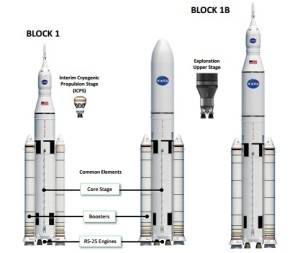
Figure 7. The Block 1 and the Block 1B configurations of the SLS. Image: NASA
Figure 8. NASA budget as a percentage of the federal budget
Figure 9. Commercial Cargo Program Suppliers. Images: SpaceX and Orbital Sciences Corp.
Figure 10. Commercial Crew Program Suppliers. Images: SpaceX and Boeing
